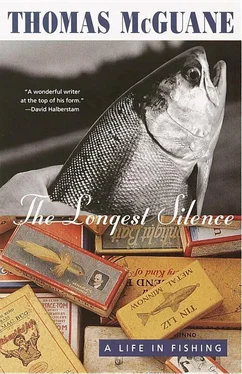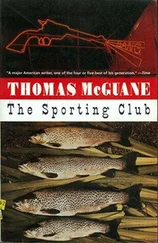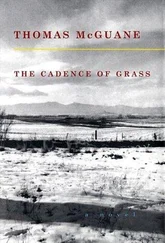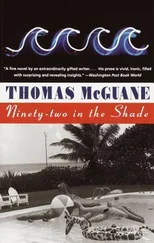Guy poles to an interception point and turns the skiff in such a way we’re at rest by the time the fish is in range. The pole is down and away from where my backcast could foul it. I roll my trailing line into the air, false-cast, shoot, false-cast again, shoot, get my range, and cast. The fly falls acceptably and I strip sharply once to get the fish’s attention, continuing with a quick, jerky retrieve. Then the tarpon turns almost imperceptibly: the enthralling, terrifying moment when, unbelievably, the great fish alters its course, however slightly, to take the fly.
Now the fish is tight behind the fly, so close as to seem cross-eyed as he watches and follows it, a dense reptilian presence in pursuit of the streamer. Then comes his slight elevation and gain of speed, the mouth opening, and one last forward surge as the fly vanishes.
I strike him too quickly and feel little more than a bump as the fly comes free. The tarpon muscles about in confusion, making a depth charge of disturbance when he sees the boat, and turns over on himself clearing out. We should be fighting that fish now, one reflects gloomily. Yes, one is inclined to admit, one has blown off a good fish.
To seize the rod with a pontifical sigh and hand me the push pole would be Guy’s every right, but he remains in the bow, camera around his neck, ready to record each new faux pas.
I return to my post in the stern with that special determination that surely prepares the angler for more garish errors than those which produced the determination. This is the vicious circle of angling, the iron maiden of a supposedly reflective pursuit.
We pole for a good long time without sighting another fish. We are beginning to lose our tide here, and the time has come to think of another move. We sit down in the skiff, drifting under the dome of unsoiled marine sky. Guy hands me a sandwich and we have our lunch, chewing and ruminating like cattle. We are comfortable enough together that we can fall silent for long periods of time. A flats skiff is a confined place and one in which potentials for irritation are brought to bear as surely as in an arctic cabin, but this comfort of solitude enhanced by companionship is the rarest commodity of angling. Pure solitude, nearly its equal, is rather more available.
Lunchtime, between tides, with the boat drifting before the wind: our piddling inclinations toward philosophy begin to emerge. My recent failure with the fly rod exaggerates my proclivity for higher things. We talk about “the meat bucket.” Originally, the term indicated a particular place in the water that held fish in quantity. Then, gradually, it came to mean whole rivers or bays or banks that were good and, finally, states and regions where someone could live who could not live where the country was all shot to hell. In the end, the meat bucket was a situation of mind where everything was going to be okay. When you had gone and messed up your intelligence with whiskey or worse, jacked yourself all out of shape, the meat bucket was the final pie in the sky, the universal trout or steelhead or permit or what-all run, the place where you always threw the perfect loop and never had to live with righthand winds, cold rain, broken homes, failed religion, or long-distance releases.
The meat bucket was Bill Schaadt pantomiming coming up tight on a fifty-pound chinook on the Smith River, saying, “I’m into one!” loudly and reverently. The meat bucket was Russ Chatham making a precise delivery at a hundred feet with a hangover. The meat bucket was Jim Harrison screaming that his knees were buckling and “He’s got all my line!” on his first hundred-pound tarpon. The meat bucket was Bob Weddell laying his ear to your Hardy reel that a twelve-pound steelhead was making scream, and saying with rapture, “They’re playing our song!” The meat bucket was Bob Tusken’s lead-filled Bitch Creek nymphs hitting you in the head when you tried to cast them, Guy de la Valdene skinny-dipping between two guide boats full of glowering anglers at Cutoe Key, Chico Horvath miming a gang bang in his waders on the banks of the Firehole, Rudi Ferris sleeping on the garage floor waiting for “the bite,” Woody Sexton looking with horror at the bad housekeeping in my skiff, seawater and Lucky Strike wrappers in the dunnage box. In the end it was all the unreckonable fragments of the sport that became the reference points of an obsession that you called the meat bucket, or, among the archdiocese of angling maniacs you had come to know, more simply, the M.B.
The push pole is secured once more in its chocks; the engine is down and again we are running. This time we head southwest toward Boca Grande Key. The light is so good we can see the stilt houses from where we ride. The spongers browse around in their little boats, standing in the bow and steering the outboard motors with clothesline tied to their waists, raking up sponges like oceanic gardeners.
We are heading for Ballast Key, where we expect to find tarpon and where I have every hope that I will not fall apart and bungle either the cast, the hookup, or the sometimes appalling fight that ensues.
The keys down here have a considerably less swampy character than those above us along the Gulf of Mexico. They are higher and, in some cases, have headlands, beaches, and woods. In the spring these are great meeting places for migrant warblers headed for cool northern forests.
We shut off next to an empty beach of wild palms amid clouds of wheeling white seabirds, and Guy begins poling down the face of Ballast. There is a wash here that raises and drops the skiff. The bottom is rock and packed sand, dotted with sea fans, a desperately difficult place to pole without falling out of the boat. When fish are spotted the poling is so noisy that the tarpon are often spooked, and the boat cannot be easily or quickly positioned for incoming fish. So you abandon yourself to the combinations and hope they come up in your favor.
Almost to Woman Key, we find tarpon: a string of fish, they are traveling on a bright sandy bottom, as distinct as fractured sections of pencil lead.
We are in good position and it is now only a question of waiting for them to come within range. At first we see them from afar, splashing and marking their progress purely in surface movement. At this remove, they are no more scary than a school of feeding jacks.
Then, as they approach, their above-the-surface presence of wakes and splashes is replaced perceptually by the actual sight of fish as specific marine entities, individual torpedoes coming at you. It is hideously unnerving, if you care about fishing.
I like my cast and at the first strip two fish turn out of the string to follow. Then one of them quite aggressively takes the fly and turns off to the side. I continue the strip I started with my left hand until I come up tight. Then, with the butt of the rod in my hip and the rod tip low and to the side, I hit two or three times hard.
The fish is in the air, upside down, making a noise that reminds you of horses, thunderous and final; your eye remembers the long white rip in the ocean. Then a short accelerated run is followed by an end-swapping jump by a game animal that has pulled all the stops. At the third jump the run begins. The fourth jump would be better observed through binoculars; the line no longer even points at the fish.
The tarpon has burned off a hundred fifty yards in such a way that the centrifugal surge is felt in the reel, shuddering my arm. Now he must be followed in the boat. The backing goes onto the reel at the expense of a painful swelling of the forearm and the shirt clinging wetly. After some time the fish is close enough that we can reasonably exert some pressure. Guy keeps the boat parallel to him, silver and brilliant in the deep green water, and the fight goes on, interrupted by inexorable fifty-yard runs from which we patiently recover. Now the fish makes a number of sloshing, head-rattling jumps, after which, in his new weakness, I can turn him slightly on his side.
Читать дальше












